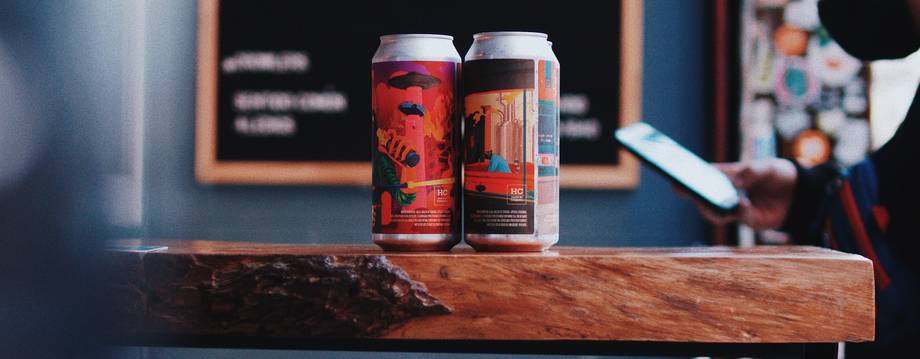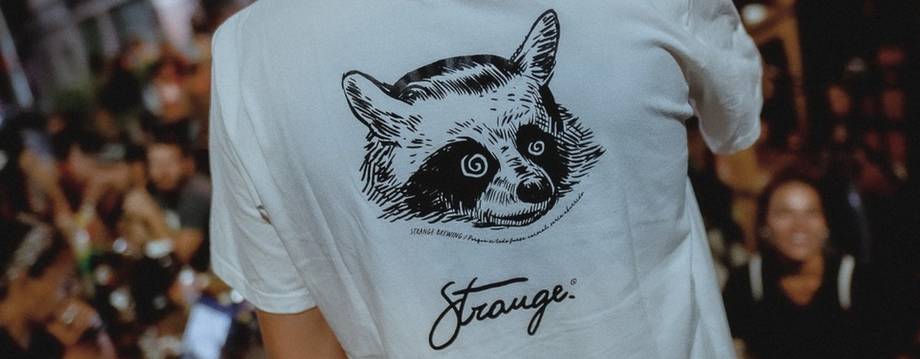Strange Brewing
Meet the strangely incredible brewery from Argentina
Robyn Gilmour
Photos:
Strange Brewing
Thursday 17 November 2022

This article is from
Ones to Watch
issue 86
Share this article
It may have been the distance between my desk and Buenos Aires, or the considered approach that co-founder, Torstein Hoset, takes to discussion of all things strange, but the story of Strange Brewing is among the most intriguing I have encountered. Torstein and I talk over zoom, some hours and several thousand miles apart, in the days leading up to his move back to Norway from Argentina, where he’ll continue to develop Strange from afar. It’s a transitional period for the brewery, one that marks its arrival at a maturity of sorts, and renders Torstein well positioned to reflect on the brewery’s journey from Argentinian trailblazer to a brand primed for international success.
Torstein started brewing with his college roommate, Ramiro Galperin, in 2013. They were studying in California and living in a cooperative housing complex where their contribution to communal life was management of the Friday BBQ, an occasion that evolved into somewhat of an Argentine asado. This was Strange’s training ground, where an enjoyment for sharing home-brewed beer developed into a playful obsession with brewing better, then later, brewing professionally. By the time graduation was in sight, Torstein and Ramiro were brewing a new beer every week, and Torstein had undertaken several internships with California-based breweries to gain experience in a professional setting. When they finished university in 2015, the pair bought a car in San Francisco and drove it all the way to Argentina.
Buenos Aires was an obvious destination for Torstein and Ramiro, with Ramiro being from the Argentinian capital, and Torstein having a keen interest in Latin American culture that he developed while travelling there some years earlier. “We visited a lot of breweries, surfed a lot, Ramiro taught me Spanish, and we built a business plan while on the road” says Torstein. “The idea was that by the time we got to Buenos Aires, seven months later, we’d have something to present to potential investors, and a much clearer idea of how craft beer worked in Latin America, at least at that point in time. I think it's changed a lot since then. But yeah, I wouldn't necessarily say we felt ready by the time we arrived.”

Torstein tells me when he and Ramiro arrived in Argentina, in 2016, the country already had an established craft scene. Beer brand Antares had been brewing since 1998 and was among the first to introduce IPA to the Argentinian market. They also brewed quite traditional styles like Scotch ale, and most notably, honey beer, which was wildly popular in Argentina through the 90s and into the late 2010s. Honey beers here refer to something slightly stronger than a golden ale with either fermented or unfermented honey in it and a sweet, boozy finish. On a wider scale, beer styles during that time fell into categories of blonde, black and red.
When Strange set up shop in 2017, the tide was beginning to turn on those trends, and evidence of US influence was becoming more apparent. Most notably though, the quality, sophistication and culture around craft beer was rapidly developing. “It's striking to me that craft has become a very democratic thing” says Torstein. “It's not as elitist as it is in other Latin American countries where it's something that's only reserved for the wealthy or well travelled. As you know, social differences here in Latin America are quite big, but Argentina is one of the few countries that has, you know, not a thriving middle class, but it does have a middle class; and the middle class here has embraced craft beer.
“Over 50% of draught beer sold in Buenos Aires is craft, and that’s not common in many other parts of the world, especially not in failing economies with 95% annual inflation. For us, that's been amazing, because we've been able to take part in that evolution, bring some new ideas to the table and do things a little differently than what was being done before we arrived. We were one of the first to introduce craft lager, hazy IPAs and mixed fermentation beer to Argentina. So, you know, nothing original, nothing too revolutionary there, but we're trying to interpret how it's been done elsewhere and adapt that to the market here. Using local ingredients when possible is also a big part of our identity, and amazing produce available here is one of the reasons we chose to start here. Argentina has everything you need to make great mixed ferm beer, from barley to hops to wine grapes, barrels and tropical fruits.”
The relationship between producer and consumer remains as important to Strange now, as it was to Torstein and Ramiro when they were catering to friends and family at their university asados. The two friends were joined by Evert Lara (Bolivia), Håvard Lenes (Norway), and Tom Urban (Argentina) to officially co-found and fit-out the brewery, but between the five of them, the ambition remained “to just have a brewpub and serve strange, out of the ordinary styles to people, and try to create some sort of culture around that.”

And create some sort of culture they have. After about a year and a half of operation, Strange began releasing mixed fermentation beers to a market that had never tried them before. “That was fun,” Torstein says. “Because, you know, if you use the right words, and lead people in the right way, then they're not weird flavours. If you like wine, if you like cider, cocktails, they're understandable flavours. And, you know, most Argentines love wine. Argentine cuisine has a decent amount of acidity in it – there's a lot of lemon and pickles – so it was just a matter of understanding or trying to understand how to communicate what those flavours were and how they were produced by putting beer in wine barrels. Today, we have customers who previously thought they didn't like beer, but now they come to the brewpub and drink only mixed fermentation.”
Torstein tells me that while the intimate and interactive element of the brewpub model is important to Strange, on a practical level, brewpubs also allow beer to be consumed at its freshest. This is a major consideration for Strange. Torstein tells me that the brewery has exported beer to Europe before, and was disappointed to find that cold freight failed along the way, and some of the retailers it arrived with didn’t take the best care they could of the beer while it was in their possession.
It is for this reason that Strange was open to the idea of contracting with Beer52. “Beer comes out better most of the time if you have an actual connection to it” says Torstein, “but I think [contracting] is preferable to shipping beer halfway across the world for quality reasons. And also for just sustainability reasons.”

We talk openly about how frightening it can be to hand over recipes that represent your brand, to contractors who you have to trust will do justice to your brewery’s process and identity. “What ended up convincing me that this would be a good opportunity for us, was that Carlos [Beer52’s head brewer and winemaker] has worked a lot with contract brewing and has a lot of experience and a lot of contacts.” says Torstein. “It would seem like we're in good hands; we sent our recipe and our process and Carlos has tried to work with breweries that fit with our profile and process, and reliably make good beer with similar products.”
I have no doubts whatsoever that Strange transplants will go down without a hitch among our readers, though I’m dubious as to whether the brewery’s logo will be as well received, without the story to explain it. So here goes; “We were pretty adamant with our designers during initial conversations in the branding process, that we wanted to have something quite out of the ordinary” says Torstein, with absolute seriousness. “We didn’t just want any normal logo, but I don't think we expected them to come up with this. We were pretty shocked when they actually presented this to us, and then we thought it was kind of funny but that we’d never use it. But then we thought, you know what, there's nothing wrong with that; it's just love at the end of the day, though maybe in a strange way.
“Over the years the logo has come to represent the irreverence and creativity our company has been built around, where the visual and literary worlds melt together in the strangest of ways, specifically through our graphics and labels. Our logo has become a motif, and has proven the epicentre of the raccoon-driven visual universe we have created over time, with each label evoking a story, usually with some degree of humour or strangeness attached to it. We work very closely with our graphic designers – Studio Patria for the logo, branding and can labels, and Studio Nice Wach for the mixed ferm bottles – to develop this form of visual storytelling, so much so that it now adds a certain three-dimensionality to our brewery”.
These designs are strange, but they’re also beautiful, and engaging and playful in a way that cannot be easily forgotten; an asset and an identity that will stand to Strange as it takes its first tentative steps into a European market. What form this emergence will take I cannot be sure. Can a brewpub specialising in mixed fermentation beers ever really be replicated? Can the feeling of Buenos Aires truly be transplanted? Or can whatever iteration of Strange comes next be a sister instead of a twin? From whatever direction the next great leap forward for Strange comes, keep an eye out; these guys are ones to watch.
Share this article

